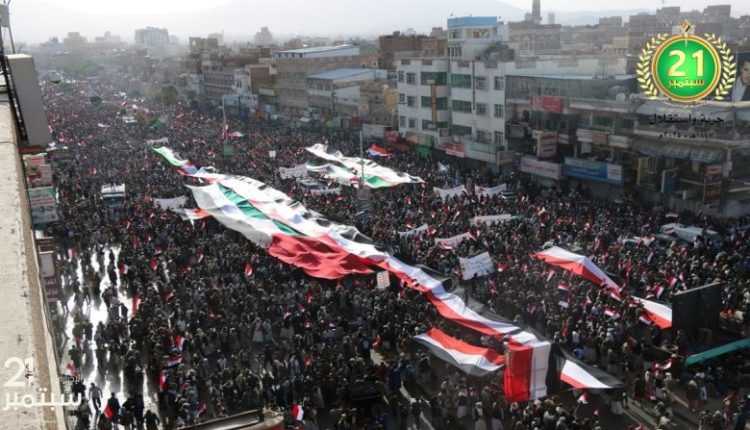21 September — A Revolution the Size of a Nation and an Earthquake That Shook the Thrones of Tyrants
Eleven years have passed since the dawn of 21 September resounded, announcing the birth of a free Yemen from the womb of suffering and tutelage. Eleven years on, the revolution carves its path like an undying sun that conquers the long night and etches on the rock of history that the will of peoples cannot be broken.
The Yemeni revolution was not a fleeting uprising but a seismic tremor that shook the thrones of tyrants and shattered the illusions of foreign tutelage, restoring to the nation the meaning of dignity and sovereignty. Since that day, Sanaa has become a destination for the free, a beacon for the oppressed, and an outstretched hand to Palestine and Gaza, where peoples test the sincerity of positions.
This is a revolution born to endure — a revolution the size of a homeland and a will the size of history. It has forged Yemen’s present and is shaping the nation’s future in confronting American-Zionist tyranny.
Tutelage and deadlock — before the revolution
Before 21 September 2014, Yemen was mired in acute political and economic crises, where suffocating American-Saudi tutelage intersected with an internal system steeped in corruption. The army was little more than a familial instrument to protect the seat of power, while the people were plunged into poverty that reached roughly half the population, amid institutional collapse and erosion of national sovereignty.
Political decision-making was entirely beholden to foreign embassies, to the point that Sanaa became a rear base for U.S. Marines and Israeli intelligence. Foreign military bases spread in Al-And and Sanaa and Ma’rib, and U.S. drone strikes claimed civilian lives across multiple governorates. The country stood on the brink of collapse, with a looted economy and structural corruption that robbed Yemenis of hope in the state’s future.
The birth of the revolution: a decisive historical moment
In that dark reality, the 21 September revolution erupted as an inevitable historical necessity, not as a mere political luxury. It was not an optional path but a rescue imperative. The masses rose to break the chains of tutelage and to overthrow the Gulf Initiative that sought to recycle corruption and hegemony.
The revolution was not a project of exclusion or vengeance but a unifying call for partnership — while also drawing a red line: there is no place for foreign domination anymore.
Achievements commensurate with the nation
Eleven years on, the 21 September revolution has shown that it was not a transient outburst but a project for building the new Yemen. Its main achievements can be summarized as follows:
Liberation from foreign tutelage: The revolution ended the era of embassies’ dominance, cutting the hand of American and Saudi interference and placing Yemeni decision-making where it rightfully belongs — in the hands of the people and their revolutionary leadership.
Building a strong national army: For the first time, the goals of the 26 September 1962 revolution were realized with the construction of a genuine national army — not a familial or subordinate force. This army stood firm against an internationally armed coalition and progressed to develop impressive strategic manufacturing capabilities.
Protecting national sovereignty: The revolution restored the meaning of sovereignty; every attempt to impose a new tutelage failed, and Yemenis resisted aggression for eleven years, proving that national will is unbreakable.
Engagement in the Ummah’s causes: The revolution did not close inwardly; it actively supported Palestine and Gaza, making the Yemeni Armed Forces a real pillar of the axis of resistance and placing Washington and “Tel Aviv” in a new deterrence equation, manifested by strikes on aircraft carriers and targeting the Zionist depth with ballistic and cruise missiles and unmanned aerial vehicles.
The difference between before and after the revolution
The gap between the two eras is measured not only by political changes but by the deep essence of the new Yemen:
Before the revolution, Yemen was dependent; today it is independent in decision.
Before the revolution, the army was an instrument of internal repression; today it is the nation’s shield against the most severe hostile coalition.
Before the revolution, sovereign decision-making was pledged to embassies; today Yemenis impose their terms on the regional and international field.
Before the revolution, Yemen was isolated and merely a pawn in foreign hands; today it is a pivotal player in the regional equation and a genuine supporter of the oppressed.
From chaos to security
One of the revolution’s most notable fruits was the restoration of internal security. Takfiri groups that wreaked havoc vanished from the scene, and Yemen’s security apparatus imposed stability through its national capabilities, restoring citizen

